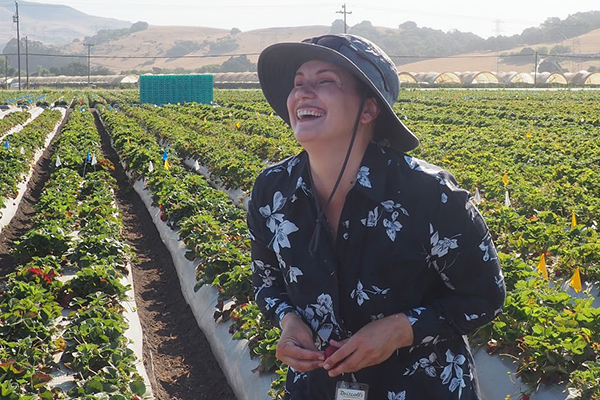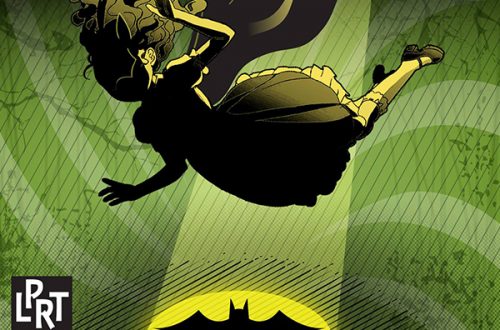

A Day-in-the-Life of a Driscoll’s Strawberry
by Jeanette Prather

The Sensory Panel team at Driscoll’s is composed of seven individuals who went through an extremely specific three-month training for flavor analyzing before moving on to testing and evaluating the berries, is one of the many steps that Driscoll’s takes to ensure that its berries meet the standard of “Only the Finest Berries
Who knew that one strawberry could yield hundreds of taste testers, a plethora of scientific analysis, as well as a cascade of careers? For Driscoll’s, the Central Coast’s centuries old and family-owned berry farm, this is not just a far-out question but rather just a day-in-the-life of your average Driscoll’s strawberry.
“I’m enjoying my second career at Driscoll’s!” said Bob Fisher, a current Sensory Panelist as well as a former sales representative at Driscoll’s. “I retired after 20 years from the sales department, wanted to get out of the house, and then tested to become a Sensory Panelist.”
That means his days are spent eating berries. Lots of them!
“Our Sensory Panelists go through a pretty rigorous screening process and maybe 25-percent of applicants will proceed to becoming a panelist,” said Driscoll’s Descriptive Analysis Director and “Joy Maker” Henry Yeung.
The Sensory Panel team at Driscoll’s is composed of seven individuals who went through an extremely specific three-month training for flavor analyzing before moving on to testing and evaluating the berries, is one of the many steps that Driscoll’s takes to ensure that its berries meet the standard of “Only the Finest Berries.” The company is seeking more berry tasters for the sweetest job in Santa Cruz. (Check driscolls.com)
The Watsonville-based company has more than 2,000 employees and grows in 21 countries on five continents and sells in 48 countries. It lays claim to $2 billion of the U.S’s $6 billion berry market. It was founded in 1849 by J.E. “Ed” Reiter and his brother-in-law, R.F. “Dick” Driscoll. It mostly sold strawberries until the 1980s when it added a rainbow of blueberries, raspberries and blackberries sold in the one-piece “clam shell” boxes it’s known for.
Prior to landing on a tray in front of the panelists (in addition to the Driscoll’s employee-appointed panel), a berry might see its DNA bred and even re-bred throughout seedling fields over the course of multiple seasons. “Each berry holds approximately 200 seeds,” said Jane Kostina, Driscoll’s Strawberry Trade Specialist. “And every single one of the seeds will be a plant in the seedling area: siblings from the same family of characteristics. Strawberry runners produce daughters that basically clone themselves (which we like) and then the nursery maintains that, so we keep getting the same quality of berry from the parent plant.”
Cuttings are taken from an original selected seedling and grown in the germ-free environment of Driscoll’s screen houses. From there, the seedlings are planted and grown in nursery fields, a process that can take several years.
The science behind it is a fascinating balance between precision and nature. “We pick two plants that we like the traits of the most, and/or they have complimentary aspects to one another, and add pollen from one to the other,” said Global Plant Breeding Director of Strawberries, Philip Stewart. “Because the flowers are both male and female, we take the outer, male parts off of the flower, and then sprinkle the pollen onto the center of the now-female flower.
“At roughly one million berries grown per acre per year, Driscoll’s probably comes close to 12 billion berries per year,” continued Stewart.
Among these, Driscoll’s might see 250 varieties of strawberry types with traits the company is interested in, not all of them with the intention for commercial sale. “If there are traits that we like in those strawberries, we might breed them back into commercial stock,” said Stewart. “It can be a four- or five-year process to knock the thousands of strawberry variations down to two or three varieties,” added Yeung.
Some of these non-commercial grade strawberries within Driscoll’s grazing plot, includes the greenish white Vesca strawberry that is a cross between a Hawaiian and Pakistani wild strawberry grown in the northern hemisphere with a sour, tangy flavor, as well as a Japanese variation berry that maintains a sweet taste and is aesthetically beautiful.
“Some of the more unusual flavors can be isolated to test if they’ll work within Driscoll’s standards, which maintains a consistent and predictable brand,” said Stewart.
“Sometimes you get a type of flavor; earthy vs. sour vs. bitter,” added Fisher. “Was it a drawing flavor? Did it cause you to pucker? Was it too seedy? These are all factors.”
Another non-commercial strawberry variation is the popular unnamed wild strawberry from a beach in Santa Cruz County that maintains a light color and tastes like pink lemonade (which a blindfolded amateur taster might not even guess is a strawberry and is something no consumer has yet tasted). To ensure their fields are organic, Driscoll’s also harvests insects with a giant rolling vacuum machine, rather than using pesticides.
“Driscoll’s doesn’t stray too far from their standards of what constitutes a perfect berry,” said Kostina. “There are many factors that include its heart shape, the berry’s sweetness, density, and even the harvestability. You don’t want the berry to be covered by a bunch of leaves because that takes too long to find and pick. Also, the way that the berry comes off the runner matters. You don’t want the inside of the berry to come out when you pick it, you want it to come off the vine naturally. The berry should have seeds that aren’t too raised, nor the neck of the strawberry too long, for example.”
Kostina demonstrated the technical way to extract a strawberry from its grey plastic runner as cupping her hand upwards to the sky with the strawberry resting in her palm, and then giving it a slight twist as she pulled the strawberry off the vine. “If it doesn’t come off easily, it’s an automatic fail.”
According to Kostina, some of the older berry varieties tended to be smaller with more complex flavors, while some of the newer, larger berries taste fresher and sweet with more aromatic qualities. “It’s not true that the darker berries are more pungent than lighter berries,” she added. An average day in the field tasting berries can lend itself to at least three pounds of fruit consumed. “In some places in Europe they eat berries that are almost orange.”
A good example of not judging the berry by its color, comes from Driscoll’s special edition Rosé Berries™. “Our Rosé Berries™ have a unique, complex flavor that will heighten your summer berry dishes. The blush color comes from a natural blend of light and dark berries mixed with the power of the sun,” says their PR department. “Rosé Berries™ contain sweet, peachy notes capped off with a soft, floral finish that’s as delicate as a rose. Plus, their smooth, silky and creamy texture perfectly complements a hot, summer afternoon.”
The limited series berry maintained a pink-to-yellow gradient color reminiscent of a retro beach party mid-summer. “It’s sweet and a bit tropical,” said Stewart. “This berry contains the standard Driscoll’s variety with a French variant that produces a grape flavor in the background.”
What’s next for a Driscoll’s strawberry?
The 25,000 strawberry seedling variants (which can include seedlings from Florida, Mexico, Europe as well as other parts of California, and can crossbreed among the geographical locations) are flagged to pass, be further assessed, or fail, which brings the total number of seedlings moving to stage one, to 250 variants. “A year after we’ve selected the 250 varieties, we’ll choose 25 more, and then narrow it down further to five or six plants,” said Kostina. “The following year we’ll choose maybe two or three plants that we’ll look at patenting. The various stages throughout the various years overlap each other.”
The stage-one passing berries get a yellow flag, berries not passing on get a red flag, and those needing to be reassessed get a blue flag, which puts it through a thorough Driscoll’s-created internal app that details a lot of scientific information and statistics, as well as another round of plant aesthetics, health, shape, and size, to name a few categories. “We pull the info from the app weekly for seedlings to move on to stage one,” said Stewart who monitors the berries with an iPhone app.
Within the non-fumigated stage one test plot, about 25 plants will move on to stage two, which involves them performing within Driscoll’s’ growers’ fields. “From stage two through commercial, we might see 40 plant plots with several per variety,” said Stewart. “This is where we receive detailed flavor analysis and tests that go out to a large number of people. A typical year will see 70,000 strawberry tastings (one year we had 100,000 tastings!).”
This is the phase where Driscoll’s’ newly adopted Sensory Panelist team gets to put their hundreds of hours of rigorous taste training to the test. “We really try to pull out their odor memory, and now they’re experts in flavor extraction,” said Katherine Phetxhumphou, Driscoll’s Descriptive Analyst. “Their sensory acuity is much better than the average consumer because of the training they’ve gone through.”
Berry tasters first taste all kinds of things you’d find on a spice rack and supermarket shelf, including garlic and pepper and have to learn to describe them. In some food businesses, such as coffee growers, tasters are highly trained and well-paid and are often poached by the competition, said Yeung. Driscoll’s prefers a more democratic approach by training a larger number of tasters and treating them like family so they will enjoy working there.
“I was just on a trip to see relatives in Portland and in Seattle, and the reality was that I would taste things at their various homes, picking out some specific flavors that I wouldn’t have asked about or been able to even talk about a year ago,” said Fisher. “Being a Driscoll’s Sensory Panelist has made me more acutely aware of the flavors in food, the intricacies, and the heightened level of awareness when it comes to flavor.
“They have an array of flavors varying from different fruits to umami (synonymous with many Asian foods). For example, a berry might not just taste like an apple, but perhaps an apple and kombucha. It’s really about narrowing down the flavor profile,” continued Fisher. “I’ve since learned that’s an essence of some of the berries; a certain savory aspect that I never would have affiliated to this particular flavor. A lot of us in the group are learning about the balance between savory, sweet and even more in regards to flavor. It’s interesting to see how we’re moving these markers to breeding so that the consumers get what they want.”
From crop to clam shell (the official name of a strawberry container), these berries make quite a journey that varies between terrain and tester, all things considered. “Driscoll’s takes into consideration all elements within the farming process,” said Yeung. “Everything from the harvest to flavor to consumer are all factors.”
“The song ‘Strawberry Fields Forever’ is so ominous to me now,” laughed Kostina. “I get so tired of strawberries at the end of the day, but then I wake up the next morning excited and ready to go.”
Jeanette got her BA in journalism, French, international studies, and dance at Cal State, Long Beach circa 2007. Since then, she has published thousands of articles and blogs from zines to dailies to traditional glossies, as well as four books, and six musicals. She runs a local business, Stellaria Creative Company, and resides in Santa Cruz with her husband and two children.


You May Also Like

Santa Cruz Montessori
June 29, 2021
Mac vs PC
June 29, 2021

